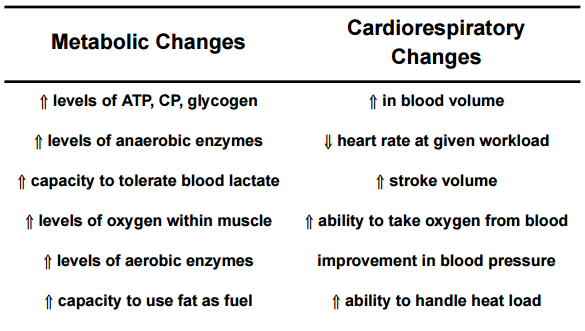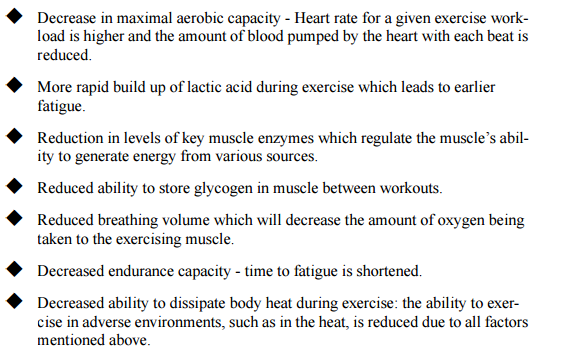Methods of Physical Training For Motocross
Most people think of exercise as being either aerobic or anaerobic. However, in most types of exercise, a blend of both aerobic and anaerobic exercise is involved. For example, during a 1500 m run, energy is provided by anaerobic metabolism at the beginning and the end of the run whereas aerobic metabolism supports the middle or the steady state part of the run.
Aerobic and anaerobic capacity can be improved by using appropriate physical training techniques. The contribution of the three energy systems to the various training methods is shown in Table below. The various physical training techniques are presented below, and can be used for enhancing performance during various physical activities.

Interval Training
Exercise bouts are alternated with rest or relief periods. Relief periods usually involve mild to light exercise. Generally, in swimming no exercise is performed during the relief periods. The duration, intensity, and number (repetitions) of exercise bouts and the length and type of relief intervals are chosen to suit specific exercise performance requirements. Interval training allows you to exercise at a higher intensity than you could if you were exercising continuously. This type of training helps to develop the muscle ATPPC energy system. Both aerobic and anaerobic metabolism can be improved by interval training. This is perfect combo for riding motocross.
Sprint Training
Sprint training helps develop speed and increase muscle strength. Individuals are required to sprint repeatedly at maximum speed while allowing for complete recovery between sprints. In general, 6 seconds are needed to go from a stationary position to maximum speed. For a runner this would mean running 55 to 60 meters to reach that maximum speed.
Interval Sprints
This method involves alternately sprinting for 45 to 50 meters and jogging for 55 to 60 meters while covering a distance of about 3 miles. Interval sprinting helps to develop aerobic capacity.
Acceleration Sprints
Acceleration sprint training develops speed and strength. Running speed is gradually increased from jogging to striding to sprinting, followed by a recovery walk. This sequence is repeated. Intervals may range from 50 to 100 meters each. For example: 50 meters jogging, 50 meters striding, 50 meters sprinting and 50 meters walking.
Fartlek or Speed Play
The work Fartlek means “speed play” in Swedish. It involves running at fast and slow speeds on both level and hilly courses. Unlike interval training, the fartlek form of training does not involve specific exercise and rest periods; you do it as desired. For example, you may say to your buddy “I’ll race you to the next stop sign”, and you would both run as fast as you can to that point. You may run at a slower pace for a few minutes, and then run fast again for as long as you want. In other words, it is a speed workout without structure. As such, it is well suited to general conditioning and provides variety to workouts.
Continuous Exercise Training
This type of training is needed to build endurance for activities such as distance running and open ocean swimming. Exercise is performed with distance in mind and may be done at a slow or a fast pace. The aerobic system is the main energy source for this type of activity.
Repetition Running
This method is similar to interval training, but unlike interval training, the length of the intervals are longer and usually range from 0.5 to 2.0 miles. Recovery between intervals lasts until the heart rate is under 120 beats per minute, or within 60% of your estimated Max HR.
Conditioning and Deconditioning
Conditioning and deconditioning, also known as training and detraining, are responsible for gains and losses, respectively, in fitness levels. Whereas conditioning is a gradual process and may take six or more weeks to see specific effects, deconditioning occurs relatively quickly. Some of the various metabolic and cardiorespiratory effects of conditioning are presented below
![]()

Effects of deconditioning will be noticed within one to four weeks. Deconditioning reverses the positive metabolic, cardiac, respiratory and muscle enzyme effects that result from conditioning. Some major effects of deconditioning include:

Retraining is necessary to reverse the performance reducing effects of deconditioning. However, deconditioning can be prevented or minimized by maintaining usual exercise intensity during endurance and strength workouts, when the number or length of work outs is decreased. Aerobic capacity and decreased lactic acid accumulation during exercise can be maintained by training at least two to three times per week at your usual training intensity. Strength gains can be maintained by including one to two strength training workouts sessions per week.
Active Recovery
This type of recovery means that you continue to exercise at a low to moderate (30% to 50% of your maximal heart rate) intensity for several minutes after your regular workout. For example, walk for 5 to 10 minutes after completing a run.
Cooling Down and Stretching
Upon the completion of a training routine, cooling down and stretching should not be overlooked. The cool-down should be gradual to normalize body temperature, prevent pooling of blood in the muscles and return metabolic rates to pre-exercise levels. It also speeds the removal of waste products which tend to increase muscle soreness and prolong recovery. Stretching after weight training maintains joint and muscle flexibility while minimizing muscle spasms and weight training injuries.
Check out are 138 page Pro Motocross Fitness Training & Riding Techniques Manual For The Special Price of $9.95



